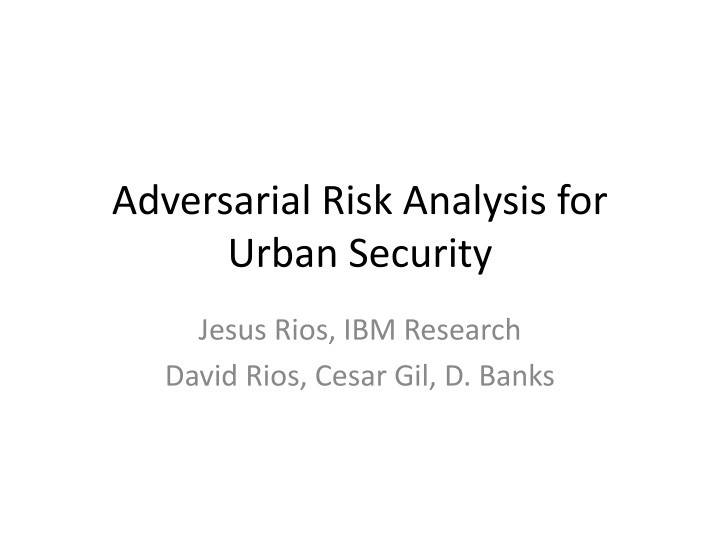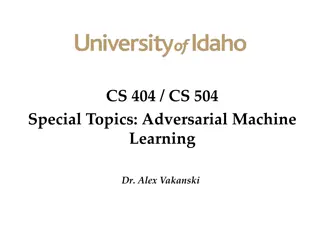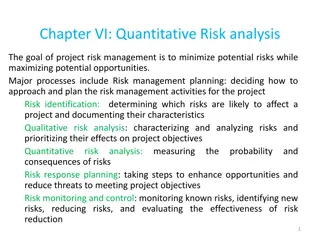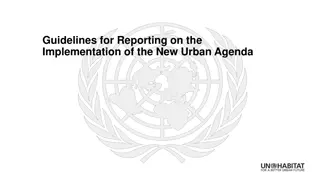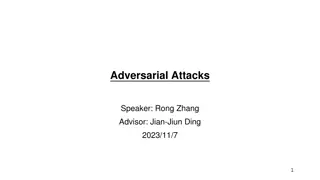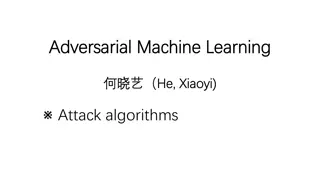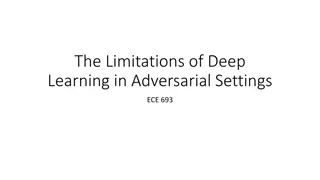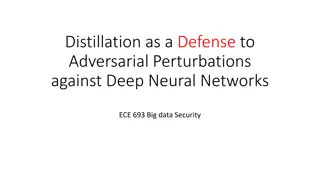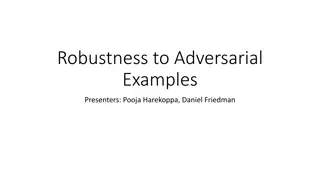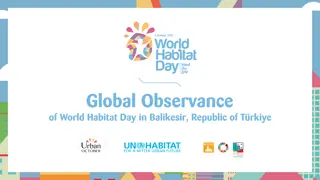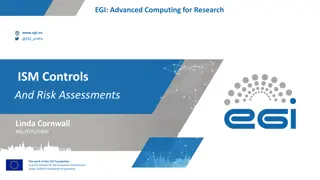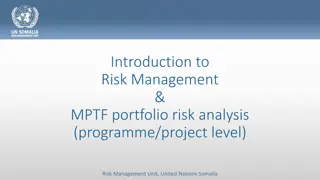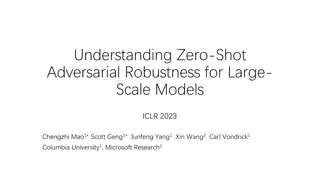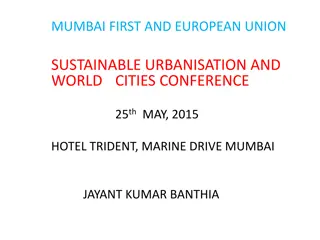Adversarial Risk Analysis for Urban Security
Adversarial Risk Analysis for Urban Security is a framework aimed at managing risks from the actions of intelligent adversaries in urban security scenarios. The framework employs a Defend-Attack-Defend model where two intelligent players, a Defender and an Attacker, engage in sequential moves, with the Defender deploying defense resources first, and the Attacker choosing an attack in response. By assessing the Adversary's decision problem, probabilities, and utilities, the model aims to predict and respond effectively to potential threats. The approach involves utilizing a SEU model and considering uncertainties in the Attacker's decision-making process.
Download Presentation

Please find below an Image/Link to download the presentation.
The content on the website is provided AS IS for your information and personal use only. It may not be sold, licensed, or shared on other websites without obtaining consent from the author.If you encounter any issues during the download, it is possible that the publisher has removed the file from their server.
You are allowed to download the files provided on this website for personal or commercial use, subject to the condition that they are used lawfully. All files are the property of their respective owners.
The content on the website is provided AS IS for your information and personal use only. It may not be sold, licensed, or shared on other websites without obtaining consent from the author.
E N D
Presentation Transcript
Adversarial Risk Analysis for Urban Security Jesus Rios, IBM Research David Rios, Cesar Gil, D. Banks
Outline Adversarial Risk Analysis The sequential Defend-Attack-Defend Model Urban security resource allocation problem Discussion 2
Adversarial Risk Analysis A framework to manage risks from actions of intelligent adversaries One-sided prescriptive support Use a SEU model Treat the adversary s decision as uncertainties New method to predict adversary s actions We assume the adversary is an expected utility maximizer Model his decision problem Assess his probabilities and utilities Find his action of maximum expected utility But other descriptive models are possible Uncertainty in the Attacker s decision stems from our uncertainty about his probabilities and utilities 3
DefendAttackDefend model Two intelligent players Defender Attacker Sequential moves Defender moves first, deploying defense resources Attacker observes Defender s move and choose an attack Defender moves again responding to the attack 4
Standard Game Theory Analysis Under common knowledge of utilities and probs At node Expected utilities at node S Best Attacker s decision at node A Best Defender s decision at node Solution: 6
ARA: Supporting the Defender At node A At node ? 8
Assessing Attacker s problem as seen by the Defender 9
Assessing 10
Monte-Carlo approximation of Drawn Generate by Approximate 11
The assessment of The Defender may want to exploit information about how the Attacker analyzes her problem Hierarchy of decision analysis Infinite regress 12
Urban security resource allocation Players A mayor (Defender) aims at protecting multiple city districts The mob (Attacker) aims at controlling as much value from city districts Resources to be allocated across the city districts Mayor Squad car 1 Foot patrolmen 2 Mob Burglars 2 13
Urban security resource allocation City topology and Mayor s values A district provides no value when it is not controlled Districts 1 Defend-attack-defend setting Mayor chooses an initial assignment of resources across districts squad car patrolmen The mob sees this and allocates his burglars Mayor has only time to move the squad car to a neighboring district at a cost k = 5 units of value Payoffs from controlling each district are determined at t = 3 Who has control of each district at the end of the game Si = 1 Mayor, 0 Mob; i = 1,2,3 District 2 3 t = 1 t = 2 t = 3 14
Game theoretic approach Common knowledge Mayor and Mob s utility and probabilities Probability that the mayor controls a district 15
Game theoretic approach Payoffs from controlling districts (additive) Mayor and Mob are risk neutral 16
Backward induction Mayor best response at t = 3 Mob s best response at t = 2 Mayor optimal initial allocation at t = 1 18
Game Theory solution GT prediction 1 2 3 City topology and values Optimal decision path 19
ARA approach Weaken common knowledge assumption Mayor does not know with certitude Mob s utilities and probabilities Solve for the mayor (a level-2 thinker) 1. Assess predictive probability of Mob s response vs. 2. Find Mayors allocation (and re-allocation) of MEU 20
Assessments needed to elicit . Mob s valuations for each city district , Prob. of controlling a district pD = p, but 21
Assessments needed to elicit . Mayor level-2 thinker => Mob level-1 thinker Mob tries to anticipate mayor s decision Mob observes D1 Mob sees the mayor solving at t = 3 Mayor needs to assess Mob s estimates of her uD and pD 22
Mayor assessments of Mobs estimates for her utility and probability Mob s estimate of her district values v Mob s estimate of her cost for moving the squad car Mayor beliefs about the mob s estimate of her utility Mayor beliefs about his estimate of her probabilites 23
ARA solution MC estimate of Mayor optimal allocation reallocation response 24
ARA solution Mob allocates Squad car to district of most value (0 0 1) One patrolman to each of the other two districts (1 1 0) She believes that Other burglar allocations are possible vs. deterministic GT prediction Mayor moves squad car to (0 1 0) only when A2 = (1 1 0) or (0 2 0) Which she estimates will happened with prob 0.14 GT best response 25
ARA vs. GT solutions Three best ARA solutions 001|110, 100|011, 010|101 cover all districts with some defensive resource Only one among the 5 best GT solutions does this Leaving uncover the district of less value for the mayor GT solution predicts that the mob will always allocate one of his two burglars to the highest value district 26
Discussion Are available resources to a player known to the other? Mob seen as a level-1 thinker who uses GT to find her allocation decision after estimating her u and p Other rationality models for the Mob Sensitivity analysis around GT assumption before ARA focus elicitation around most relevant ARA assessments 27
